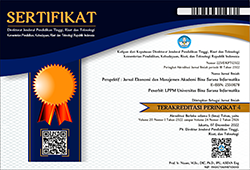Determinan Ketimpangan Pendidikan Provinsi di Indonesia
Abstract
In reducing income inequality, of them is by lowering education inequality. Reducing educational inequality is one of the government's policies through a budget of 20% of the APBN and APBD for the education sector. The education budget is to facilitate the community in carrying out education and improve indicators of educational success. This study aims to analyze the determinants of educational inequality in the Province of Indonesia as a recommendation for reducing income inequality. The independent variables that affect income inequality in this research are education inequality, elementary school dropout rate, junior high school dropout rate, GRDP on the basis of constant prices, and government spending on education. The research method uses fixed effect panel data (Generalized Least Square), the results of the study show that educational inequality, elementary school dropout rates, and junior high school dropout rates have a significant and positive effect on income inequality, while GRDP is based on constant prices and sectoral government spending education has a significant and negative effect on educational inequality.
Keywords: Gini ratio; inequality education; panel data
Full Text:
PDFReferences
Abdelbaki, H. H., 2012. An Analysis of Income Inequality and Education Inequality in Bahrain. Modern Economy, 3(5), pp. 675-685.
Agrawal, T., 2014. Educational inequality in rural and urban India. International Journal of Educational Development, 34(1), pp. 11-19.
Ariutama, I. G. A. & Syahrul, 2017. Analisis Panel Var: Tingkat Pendidikan, Tingkat Kesehatan dan Ketimpangan Pendapatan di Indonesia. Info Artha, pp. 1-16.
Bustomi, M. J., 2012. Ketimpangan Pendidikan Antara Kabupaten/Kota dan Implikasinya di Provinsi Jawa Tengah. Economics Development Analysis Journal, 1(2), pp. 1-10.
Fan, C. C. & Mingjie, S., 2008. Regional Inequality in China, 1978–2006. Eurasian Geography and Economics, 49(1), pp. 1-20.
Gregorio, J. & Lee, J., 2002. Education and Income Inequality: New Evidence from Cross-Country Data. Review of Income and Wealth, 48(1), pp. 395-416.
Hamzah, F., Rosyadi & Metasari, K., 2017. Pengaruh Pengeluaran Pemerintah Bidang Pendidikan, Gender Gap dan Pendapatan Per Kapita Terhadap Ketimpangan Pendidikan dan Ketimpangan Pendapatan Kabupaten/Kota di Provinsi Kalimantan Barat. Jurnal Ekonomi Bisnis dan Kewirausahaan, 6(2), pp. 77-96.
Hendajany, N., Riyadi, D. R. & Bakar, N. A. A., 2022. Exploring Education Gini on a Smaller Scale: How Education Inequality Differs among Districts. Jurnal Ekonomi dan Studi Pembangunan, 14(2), pp. 122-135.
Komar, O., 2004. Keterkaitan Kualitas Penduduk dengan Masalah Pendidikan. Jurnal Kependudukan Padjajaran, pp. 87-94.
Leeuwen, B. & Foldvari, P., 2010. Should less inequality in education lead to a more equal income distribution?. Education Economics, pp. 1-26.
Liao, M. & Hua, S., 2011. Education Inequality Analysis: International Comparison. International Journal of Business and Social Science, 2(16), pp. 88-93.
Masyithah, 2011. Ketimpangan Pendidikan Antar Kabupaten/Kota dan Faktor-Faktor Yang Mempengaruhinya di Provinsi Jawa Tengah 2005-2009. Yogyakarta: Universitas Gajah Mada.
Mesa, E. P., 2007. Measuring education inequality in the Philippines. The Philippine Review of Economics, 44(2), pp. 33-70.
Nadhifah, T. & Wibowo, M. G., 2021. Determinan Ketimpangan Pendapatan Masyarakat di Daerah Istimewa Yogyakarta. Jurnal Ekonomi dan Bisnis, 24(1), pp. 39-52.
Nur Azmi Randa, S. U. S., 2020. Analisis Kausalitas Antara Ketimpangan Pendidikan, Ketimpangan Pendapatan, dan Kemiskinan Di Indonesia. Jurnal Kajian Ekonomi Dan Pembangunan, 2(1), pp. 65-74.
Oksamulya, A. & Anis, A., 2020. Analisis Determinan Ketimpangan Pendapatan di Indonesia. Jurnal Kajian Ekonomi dan Pembangunan, 2(2), pp. 19-24.
Oxfam, 2017. Oxfam Annual Report, s.l.: Oxfam.
Rahayu, A., 2005. Ketimpangan Pendidikan di Indonesia. Jurnal Ekonomi & Studi Pembangunan, 6(1), pp. 21-40.
Ram, R., 1984. Population increase, economic growth, educational inequality, and income distribution: some recent evidence. J Dev Econ, 14(3), pp. 419-428.
Rodríguez-Pose, A. & Tselios, V., 2009. Education and Income Inequality in the Regions of the European Union. Journal of Regional Science, 49(1), pp. 411-437.
Saputra, D., Syechalad, M. N. & Nasir, M., 2015. Analisis ketimpangan Pendidikan terhadap Pertumbuhan Ekonomi di Provinsi Aceh. Jurnal Ilmu Ekonomi, 3(2), pp. 1-9.
Setyadi, S., 2022. The Role Of Government Spending In Education Inequality: Evidence From Indonesia With A Panel Data Analysis. Journal of Applied Business, Taxation and Economics Research, 1(6), pp. 667-675.
Solikhah, N., Suratman, B., Soesatyo, Y. & Soejoto, A., 2014. Analisis Faktor yang Mempengaruhi Ketimpangan Pendidikan. Jurnal Ilmu Pendidikan, 20(2), pp. 176-182.
Sylwester, K., 2000. Income inequality, education expenditures, and growth. Journal of Development Economics, 63(2), pp. 379-398.
Thomas, V., Wang, Y. & Fan, X., 2001. Measuring Education Inequality: Gini Coefficients of Education. SSRN, pp. 1-37.
Todaro, M. P. & Smith, S. C., 2011. Economic Development. s.l.:PrenticeHaII.
Todaro, M. & Smith, S., 2004. Economic Development. 8th Edition. New York: Longman Publication.
United Nation Development Programme, 2016. Human Development Report 2016: Human Development for Everyone, New York: UNDP.
Wahyuni, R. N. T. & Monika, A. K., 2016. Pengaruh Pendidikan Terhadap Ketimpangan Pendapatan Tenaga Kerja di Indonesia. Jurnal Kependudukan Indonesia, 11(1), pp. 15-28.
Widyastuti & Indrawati, L. R., 2021. Analisis Determinan Ketimpangan Pendapatan Di Provinsi Jawa Barat Tahun 2015-2020. Jurnal Ekonomi Pembangunan (JEP), 10(2), pp. 95-104.
World Bank, 2016. Poverty and Shared Prosperity 2016 : Taking on Inequality, Washington DC: World Bank Group.
Yang, J., Huang, X. & Liu, X., 2014. An analysis of education inequality in China. International Journal of Educational Development, 37(1), pp. 2-10.
Yang, J. & Qiu, M., 2016. The impact of education on income inequality and intergenerational mobility. China Economic Review, 37(1), pp. 110-125.
Yasmin, 2016. Hubungan Disiplin dengan Tanggung Jawab Belajar Siswa. Jurnal Pendidikan, 1(4), pp. 692-697.
DOI: https://doi.org/10.31294/jp.v21i1.15610
Copyright (c) 2023 Bayu Kharisma

This work is licensed under a Creative Commons Attribution-ShareAlike 4.0 International License.
dipublikasikan oleh LPPM Universitas Bina Sarana Informatika Jakarta
Jl. Kramat Raya No.98, Kwitang, Kec. Senen, Kota Jakarta Pusat, DKI Jakarta 10450

This work is licensed under a Creative Commons Attribution-ShareAlike 4.0 International License









